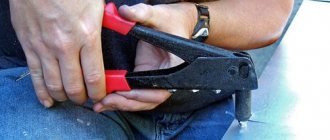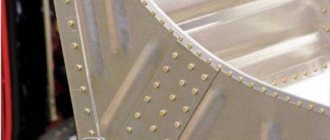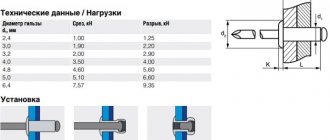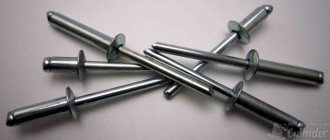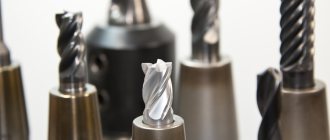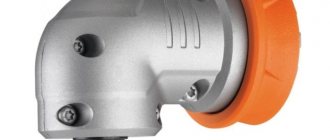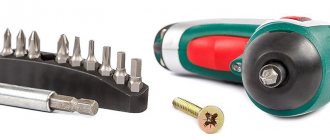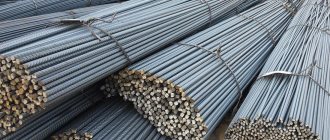Main types of rivet hardware
All rivets are of two types - threaded and blind, both types of rivets are installed due to deformation that occurs from the pulling force of a special tool - a riveter.
Blind rivets
Blind rivets
consist of a rivet body with a side (flange) and a pull rod, which, when pulled out, deforms the tail part of the rivet body, forming a reverse head that tightens the connected elements. After reaching the maximum traction force, the rod breaks off in a special separation zone, forming a reliable, permanent connection.
Threaded rivets
Threaded rivets
are one-component, and are used to create a strong collapsible connection, while threaded rivets are placed on only one sheet (surface), and the second sheet or material is attracted to the first by screwing a bolt, screw, etc. into the thread.
Threaded rivets are much more commonly used to hold multiple parts together, allowing threads to be created on thin material where threads cannot be cut. At the same time, they do not have any special restrictions in use and provide reliable fixation of all structural elements using a collapsible threaded connection of parts.
Nut samples of a threaded rivet have a thread on the inside, and bolt samples have a thread on the outer (protruding) part.
How to use?
Using rivets is not too difficult - for cylindrical products you can even do without a special tool, just a regular hammer. You can work very successfully even in “field” conditions, not to mention in a full-fledged workshop. The largest steel rivets are used in the assembly of bridges and overpasses. Smaller products are in demand in mechanical engineering and instrument making
Important: riveted joints by default are not tight enough, and they can be sealed properly only by using sealants and special grades of rubber
A hole is usually pre-drilled. If a countersunk rivet is used, countersinking is recommended. The process for a blind rivet is something like this:
- insert a rivet;
- tighten the necessary parts;
- form the closing head (using a tool);
- check the readiness of the connection and, if necessary, clean it.
To learn how to make a steel rivet with your own hands, see the following video.
Types of rivets
Before we figure out what types of rivets there are, let’s define that a rivet is a special fastener created to reduce production costs and make work easier. Special differences in hardware allow you to select the best option for specific fastenings.
Blind rivets open
The basic (standard) rivet is a fastener with a through hole. It is often confused with a hollow rivet, but the main difference is that a hollow rivet is installed with access from both sides, while a blind rivet can be installed on one side, much easier and faster. Speaking about areas of application, we can cite as an example the use of standard blind rivets when installing ventilated facades or assembling house structures made of metal frames. It all depends on the material and diameter of the rivet, but in any case the connection is quite strong and reliable. Installation features allow for minor differences in the diameter of the rivet and holes. The open type of blind rivets is the cheapest in the range.
Blind rivets closed
The main difference between closed blind rivets is the absence of a through hole; with their help, you can create a sealed structure. The body of the fastener makes it possible to “seal” the reverse side, creating a special head. Thanks to the tight fit, it becomes possible to install fasteners that prevent dust, dirt and moisture from entering the structure. The use of additional gaskets allows you to achieve a tight connection.
Closed rivets are suitable for the aviation and mechanical engineering industries.
Reinforced rivets
Reinforced rivets are also called monobolts. Necessary to create a super strong connection. Standard products are significantly inferior in terms of strength, tensile and shear forces. Another name is structural, since the created connection is not subject to vibration and has a wide range of uses. Reinforced models are used in industrial construction and mechanical engineering.
Flap rivets
By the name you can easily recognize the principle of operation of this rivet. During installation, the reverse side opens into “petals”, which, by bending, reduce the load at the attachment point, and in the case of very soft material, they can sink into it, strengthening the fixation, while almost not deforming it, but as if piercing it a little. Note that the head is not immersed in the material and remains visible. Flap rivets are needed for the installation of loose, delicate or soft materials. The head does not fall into soft material due to the fairly wide side and the small effort required for installation, which reduces the risk of cracks and deformation. An example is the connection of a smooth surface with a fibrous one, for example, wood, plastic or cellular polycarbonate.
Expansion rivets
Due to its special properties, the expansion rivet is used for the manufacture of furniture and decor; it allows connecting wooden and metal parts. Also suitable for fragile, loose and soft fabrics. The principle of operation is to form the reverse head in such a way that the load is distributed across the petals (partially divided into 3 parts). The main difference from the petal type is that the rivet is deformed and does not open completely.
Rivet nuts
Nut rivets are hardware that first has a flange, then a deformable part, and then a thread; the operating principle is similar to rivets, however, instead of a rod, there is an internal thread on the non-collapsible part.
To install a nut rivet, you need to drill a hole in the part to be fastened, screw the rivet onto the threaded part of the mandrel, which is inserted into the rivet gun and actually acts as a rod for the blind rivet, insert it into the prepared hole and retract the sleeve. The back part is deformed, forming a reliable connection with the inner surface; on the outside, the rivet is held by the side.
Multi-clamp rivets
Also types of blind rivets with an open body with a special design, which, unlike conventional blind rivets, provides multiple compression. This method of wedging the body provides high working loads to pull out.
Terminal rivets
Used for making contact connections, including creating an electrical circuit. How does a rivet work? The answer lies in the material: they are made of metals that conduct electric current (the rivet body is made of brass, and the rod is made of copper-plated steel). There are one- or two-terminal options. Terminal rivets are required to create a ground connection.
Plastic rivets
Rivet material may vary. Plastic hoods are made of polyamide, which means they provide a strong connection. In addition to the raw materials, they have a number of advantages:
- do not conduct electric current;
- not subject to corrosive effects;
- low cost.
Of course, plastic polyamide rivets are not suitable for fastening two metal plates. Used for plastic, fiberglass, cardboard structures associated with metal or other materials.
Cassette rivets
The newest type of rivets is cassette rivets. Today it is considered promising because the operator does not have to insert a single fastener each time. Cassette cartridges are presented in the form of a tape or rod for an entire magazine. A distinctive feature of the installation is that the rod does not break off, but is pulled, which significantly speeds up the installation process. One cassette contains up to 40 pieces. The special tool is not interrupted, but will automatically prepare the next batch. A bonus will be the ability to free up your second hand, which can be used to securely fix the knot.
Thus, it is impossible to single out a specific area of use of rivets in general. Each type is suitable for its own purposes, be it creating a children's playground or the largest business center. The only thing that is not in doubt is that rivets are a unique fastener that allows you to reduce installation time and cost.
What is riveting
The mechanical connection of parts using a series of rivets is called riveting, and the connection itself is called a riveted seam.
It is used where it is inconvenient to weld parts or where non-weldable materials are joined. Not only metals are riveted, but also parts in clothing, accessories, etc. are connected in this way. But there it is more of a finishing touch than a loaded connection. So next we will talk about riveting in construction or home improvement. In principle, you can use a screw connection instead of riveting, but bolts and nuts are more expensive, and their installation takes longer. Advertisement
This is what a rivet joint looks like
If we talk about installing fences made of corrugated sheets, rivets are more reliable, since they can only be removed by drilling out the fasteners. When installing screws or self-tapping screws, they can be unscrewed and both metal and hardware can be removed. In some cases, riveting is more convenient when installing a roof made of corrugated sheets or metal tiles. On the roof, installing screw connections is problematic and time consuming. But rivets, and with a good tool, can be done in an hour or even less.
Most common use in private households
How are parts connected using rivets? The rivet is installed in the prepared through hole. It has a head that rests on the material and the rod. During the riveting process, the end of the rod is flattened, changing shape under the influence of force. Therefore, ductile metals are used for these hardware.
Rivets: purpose and materials of manufacture
After we have examined in detail all the types of options on the market, we can confidently highlight several aspects of the purpose of hardware:
- those places where it is impossible to carry out welding work;
- overheating and deformation of the material structure are undesirable;
- increasing vibration resistance properties;
- the need to create a connection of increased strength.
Materials used for manufacturing:
- aluminium-magnesium alloys*;
- bronze;
- copper;
- Monel (an alloy of copper and nickel);
- stainless steel A2 or A4;
- Cink Steel;
- polyamide.
* the difference is only in the magnesium content, the higher the percentage of magnesium, the stronger, the least durable and cheapest Al (Mg1%) and the most durable which is used in blind rivets and then, as a rule, for Al (Mg5%) rods;
In some cases, combinations of these materials are used, for example, the rod may be from one alloy, and the rivet from another. Galvanized steel and aluminum are often combined. In this case, the definition of “combined” rivet is appropriate.
The principle of selecting rivets is compatibility, or better repetition, of the material, in terms of mechanical and physical properties, from which the elements being connected are made.
Another important selection criterion is susceptibility to galvanic corrosion. It manifests itself at the junction of dissimilar metals under high humidity, for example, during rain. If you are not sure how to choose rivets for a riveter, then you can use a special table of electrochemical potential. The effect of moisture will be on the more electronegative material.
When choosing a material, the following features must be taken into account:
- Ideally, choose an electropositive material for the rivet itself, so that corrosion occurs on an element that can be easily replaced;
- check compatibility using the electrochemical potential table;
- use a dielectric barrier, such as a gasket.
When purchasing rivets, it is also worth considering the operating temperature of the finished product. The fastener material and product must be matched to ensure the same thermal expansion as the temperature rises and falls. Ignoring the selection rules may lead to premature rust or other damage.
In addition to the basic elements, there are coated rivets. Powder paint is used for this, and the shade corresponds to the RAL color chart.
DIY riveter
If the installation of threaded elements is required due to duty or work, then it makes sense to purchase a factory product that operates by hand force or based on a pneumatic mechanism. In most situations, the installation of such rivets is rarely required, so you can assemble the rivet gun yourself.
Bolt based
To assemble the entire structure, you will need a bolt similar to the one shown in the photo above. It can be taken from the crankshaft of a car engine. The diameter of the bolt must be such that a hole can be drilled inside it through which another bolt with a thread size that will match that used in the rivet will be inserted. The length of the second bolt must be at least 100 mm. The length of its thread should be as long as possible; if necessary, it can be additionally trimmed with a parallel tool.
Additionally, you will need a nut that will screw freely onto the thread of a bolt with a large diameter, as well as a collapsible bearing. The inner diameter of the bearing must be such that a long bolt, which will be used for clamping, can freely pass through it. The design is quite simple to assemble. To do this, you need to insert a long bolt inside a larger one in diameter. A nut is screwed onto the large bolt, and a collapsible bearing is placed onto the threads of the long bolt.
A rivet is screwed onto the long bolt and must be installed in the hole. You will need two keys to operate. One of them will hold the nut, and the second should rotate the bolt. You can simplify the task by welding a handle to the nut. The bolt rotates until the stop becomes significant. You shouldn't be too zealous. Once the result is achieved, you need to unscrew the long bolt. The bearing in this case is a stabilizer that prevents the bolt from biting inside the structure. There is a video about this riveter below.
Advantages and disadvantages
Today, rivets are considered a universal fastener that provides reliable fastening of sheet materials. In addition, hardware has a number of other advantages.
Advantages of metal rivets:
- the connection is resistant to strong mechanical loads, vibration and shock;
- the possibility of durable fastening in places where it is impossible to use threaded options or welding equipment;
- Blind and threaded rivets are easy to install;
- A wide choice of materials reduces the risk of corrosion.
Disadvantages of rivets:
- the need to purchase special equipment for installation - a riveter;
- if the diameter of the hole and the rivet are not matched, the strength of the connection is weakened;
- impossibility of end-to-end connection without the use of additional pads;
- noisy installation of options with a closing head.
At the same time, the disadvantages of metal rivets are not always a contradictory factor. The noise can be tolerated, and overlapping installation is one of many options for assembling the structure.
Aluminum rivet sizes
What determines the choice of the size of a particular rivet? Several factors play an important role here: the type and properties of the parts being connected, the characteristics of the load, and the location of the hardware.
There is a generally accepted rule according to which hardware is chosen:
- The diameter of the rivet must exceed the thickness of the products being connected by at least 2.5-3 times.
- If the structure is subject to heavy loads, then the diameter of the rivet cannot be less than 2.5 millimeters.
Another way to determine the diameter of the rivet:
- You simply multiply the thickness of the sheathing by three.
- The diameter of the hardware is the next value after the obtained result.
- For example, the thickness of our cladding is 2 mm.
- Then 2.0 x 3 = 6 mm. That is, we will choose a rivet with a diameter of 6.2 mm.
Always choose rivets from trusted manufacturers. They will not risk their reputation and skimp on the quality of their products.
Rivet material
Depending on the material from which the rivets are made, the strength and reliability of the connection will differ. The most common options:
- aluminum. Such fasteners can reduce installation costs and, moreover, this material is fireproof (therefore, aluminum rivets are used in air ducts; when aluminum is struck by foreign objects or debris, a spark does not occur);
- stainless steel. In addition to reducing the risk of corrosion, they have high strength;
- galvanized hardware. Suitable for attaching sheet materials to other structures, for example, during the installation of gutters or metal fences.
Application
The variety of areas for using blind rivets, as already mentioned, tends to infinity. But it is still possible to identify the main industries in which this hardware has become traditional.
- Electronics and energy.
- Consumer goods of the widest profile. From complex mechanics to simple objects with a composite structure.
- Mechanical engineering.
- Construction, in the broadest sense, starting from the connection points of supporting structures and ending with interior decoration (including interior decoration).
Diameter and length
Of course, if we are talking about the independent use of rivets at home, then turning to GOST standards will be unnecessary. It’s another matter if this fastener is used in production. Regulation of the size of blind rivets to create unbreakable connections is indicated in the standards:
- GOST R ISO 15974-2005 and GOST R ISO 15973-2005 - standards for blind rivets;
- GOST R ISO 15979-2017 - blind rivet standard steel/steel side;
- GOST R ISO 15977-2017 - blind rivet standard aluminum/steel flange;
- GOST R ISO 15980-2017 - blind rivet steel/steel;
- GOST R ISO 15981-2017 - blind rivet standard aluminum/aluminum side;
- GOST R ISO 15978-2017 - blind rivet aluminum/steel;
- GOST R ISO 14488-2005 – description of the standard for “blind” rivets.

